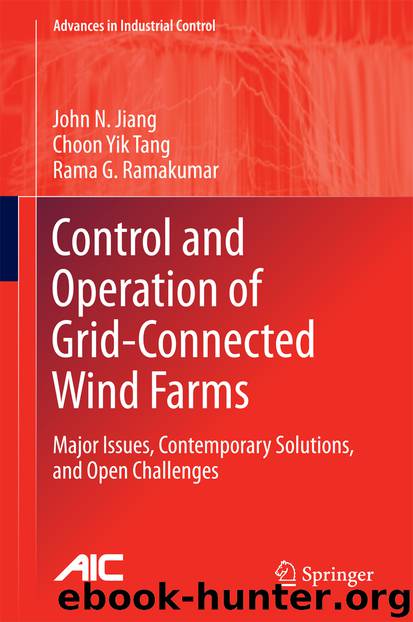Control and Operation of Grid-Connected Wind Farms by John N. Jiang Choon Yik Tang & Rama G. Ramakumar

Author:John N. Jiang, Choon Yik Tang & Rama G. Ramakumar
Language: eng
Format: epub
Publisher: Springer International Publishing, Cham
4.4 Model Predictive Controller on Outer Feedback Loop
In this section, we describe the model predictive controller on the outer feedback loop of the WFC, beginning with the Forecasts of Slow Wind Speed Components block and followed by the Optimization of Desired Power Trajectories block. We will not discuss the Reference Models block because it has been fully defined in Fig. 4.5 and has already been discussed in Sect. 4.3.
4.4.1 Forecasts of Slow Wind Speed Components
The current literature offers a large body of work on wind speed forecasting. For instance, [18] develops one of the earliest autoregressive models for simulating and forecasting wind speed on a minute-to-hour timescale, which accounts for several basic characteristics of wind speed such as its positive autocorrelation, non-Gaussian distribution, and diurnal nonstationarity. As another example, [45] from the ANEMOS project and [78] from Argonne National Laboratory each provides an extensive overview of the state-of-the-art in numerical weather prediction models and wind speed/power forecasting models that span different spatial scales (global and regional) and temporal scales (very-short-term, short-term, and medium-term) and that are constructed using different approaches (physical, statistical, and combined). Due to their survey nature, both [45, 78] also contain a large number of references that are devoted to wind speed/power forecasting. As yet another example, [64] from the recently completed Aeolus project [55, 63] uses extended Kalman filters and system identification techniques to develop a forecasting model for effective wind speeds at neighboring turbines in a wind farm, which accounts for atmospheric turbulences and wake effects.
Given that a lot of work has been done on the topic of wind speed forecasting, and given that the focus of this monograph is on wind farm control, we will not delve into this topic here. Rather, we will assume that one of the available models in the literature—such as the forecasting model in [64]—is embedded in the Forecasts of Slow Wind Speed Components block to provide accurate forecasts ’s of the slow components ’s of the wind speeds ’s, for as long into the future as is needed by the Optimization of Desired Power Trajectories block.
Download
This site does not store any files on its server. We only index and link to content provided by other sites. Please contact the content providers to delete copyright contents if any and email us, we'll remove relevant links or contents immediately.
| Automotive | Engineering |
| Transportation |
Whiskies Galore by Ian Buxton(41544)
Introduction to Aircraft Design (Cambridge Aerospace Series) by John P. Fielding(32897)
Small Unmanned Fixed-wing Aircraft Design by Andrew J. Keane Andras Sobester James P. Scanlan & András Sóbester & James P. Scanlan(32583)
Craft Beer for the Homebrewer by Michael Agnew(17940)
Turbulence by E. J. Noyes(7720)
The Complete Stick Figure Physics Tutorials by Allen Sarah(7153)
Kaplan MCAT General Chemistry Review by Kaplan(6606)
The Thirst by Nesbo Jo(6458)
Bad Blood by John Carreyrou(6286)
Modelling of Convective Heat and Mass Transfer in Rotating Flows by Igor V. Shevchuk(6232)
Learning SQL by Alan Beaulieu(6048)
Weapons of Math Destruction by Cathy O'Neil(5855)
Man-made Catastrophes and Risk Information Concealment by Dmitry Chernov & Didier Sornette(5674)
Digital Minimalism by Cal Newport;(5399)
Life 3.0: Being Human in the Age of Artificial Intelligence by Tegmark Max(5201)
iGen by Jean M. Twenge(5175)
Secrets of Antigravity Propulsion: Tesla, UFOs, and Classified Aerospace Technology by Ph.D. Paul A. Laviolette(5024)
Design of Trajectory Optimization Approach for Space Maneuver Vehicle Skip Entry Problems by Runqi Chai & Al Savvaris & Antonios Tsourdos & Senchun Chai(4851)
Electronic Devices & Circuits by Jacob Millman & Christos C. Halkias(4760)
